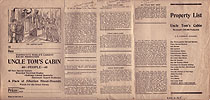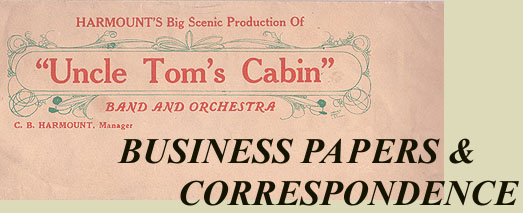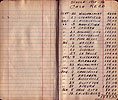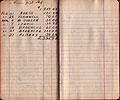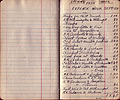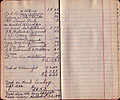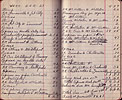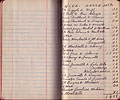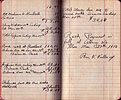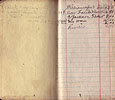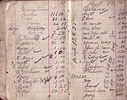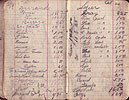The records of the Harmount company reveal a lot about both the nature of early 20th century "Tom Shows" and the economics of mass entertainment in the era just before mass communications. Below are selected items from the Harmount and Fred D. Pfening III Collections at The Jerome Lawrence and Robert E. Lee Theatre Research Institute, The Ohio State University. Most of them date from around 1915, and are organized to approximate the sequence that recured each time, summer and winter, the show went on the road.
ACTORS
Many of the Harmount performers were family members, but to complete the cast and, just as importantly, the band, the manager had to find and sign actors and musicians. The two contracts left and right below are for the Advance Agent, Ben Fuller, whose name appears on many of the other items in this exhibit, and the father-daughter combination who took on the parts of Band Leader and Eva. Note that these performers were signed for the same 1915-16 tour in different Ohio towns, and that the Band Leader made a brief appearance on stage to swell the crowd at the play's auction scene. On the back (below middle), contracts set out the rules of behavior each member of the company was supposed to adhere to throughout the tour:



Below, left: inside the front and back covers of his account book for the 1915-16 tour, manager B. F. Harmount kept track of Tommers he met or heard about, presumably not just for future reference but also to fill any vacancies that occur suddenly during the tour (see final item on this page). His notes suggest musicianship mattered more than acting ability.
Below, right: sometimes out of work Tommers found Harmount, as did Miss Bessie Lee, apparently stranded at an actors' hotel in St. Louis. She found him by writing to the company "c/o Billboard Magazine," which forwarded her letter to the group on the road in Lowell, Indiana. This indication of a national "Tom Show" network is one story the envelope from Miss Lee's letter tells; the other is the carefully torn out stamp, a recurring pattern with the envelopes among the Harmount papers. This kind of care to save 2¢ indicates how closely the company watched costs. (There's no indication, by the way, whether Miss Lee found a job.)




SETS
In June, 1915, with the company already on its summer tour, C. B. Harmount was also thinking about improving the production's special effects in the winter tour, and possibly adding a second unit, as many "Tom Shows" had done over the years, to take the show on more than one road at a time. Those thoughts led to these two letters. Left: from the company that furnished the lights used to produce the "water and snow effects" Harmount claimed as one of his company's biggest attractions (see the first and last items in the THEATERS section below); from this letter we get a sense of how both electrification and "Moving Pictures" are entering the Tommers' world. Right: from the company that designed and created the "drops" (dyed canvas sets) the company carried from town to town (you can see the drops themselves in THIS SECTION of the archive). No "#2 show" was ever organized.


ADVERTISING
It was the responsibility of the local theater to post ads in advance of the company's performance (see the THEATERS section below), but it was up to the Harmount Company to provide the posters and other promotional material. Such material was called "paper" in the trade. Donaldson Lithographing Co. (Newport, Kentucky) and the Erie Lithographing Co. (Erie, Pennsylvania) were two of the largest producers of the brightly colored posters that let the native population know a show was coming to town; the multiple-sheet posters were big enough to cover a whole fence or even the narrow side of a barn, . (You can see many of their UTC posters in THIS SECTION of the archive.) "Paper" also included the single-color "heralds" that were posted to announce the date, time and location of each show. (SEE A HERALD.)
Below: in addition to correspondence from the companies that handling printing for the Harmount's, an inventory of the types of UTC posters available from Donaldson c.1915, and Fuller's wire to Harmount requesting the money he needs to pick up the newest batch of paper for the next set of stops on the tour.
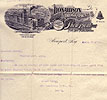






The bigger "Tom Shows," playing the major cities, advertised widely in the newspapers. It's not clear how big the Harmounts' budget was for that kind of advertising: "news paper add.--$4" is an item in one of Harmount's account books (see the TOUR EXPENSES--TROUPE section further down). But in at least the one case below, they arranged with a restaurant to have their coming attraction included on the bill of fare:

Beginning at least in the 1870s, the "Tom Shows" targeted children as a specific audience, or at least as a good means to get adults to see the show. The "matinee cards" below were a staple form of promotion for most companies, and often were handed out to children as they left school:



THEATERS
On their summer tours the Harmounts traveled with their own "theater" -- a canvas "big top" they set up fields across the midwest. During the winter season, they had to arrange bookings in local theaters. The four items below all display aspects of that process. As you'll see from the two solicitations at left, an important question always concerned competition from other "Tom" companies, half a dozen of which would also be touring the midwest at any one time. The other big question concerned the "percentage": the way the box office proceeds would be divided between the "house" (theater) and the "company" (Harmounts). The Harmounts always hoped for 75¢ of every $1, but often had to settle for 70 or even 60¢. Far right: the company traveled with many of its own sets and props, but also expected theaters to furnish some of each; the props they needed are listed on this "programme." (A sampling of replies from theaters owners in Ohio, Indiana, Michigan, Illinois, Wisconsin, Minnesota, Iowa and Missouri is available HERE.)
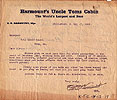



Below is the Harmount publicity kit for 1914-1916, which would have been sent to theater managers to help promote the coming show. The middle page contains a number of paragraphs for insertion in the local papers; a few handwritten notes by Fuller indicate that the items were printed at least a couple times. The 3rd page includes a review, and a more elaborate list of the props the company expected the theater to supply -- including "twenty boys for parade." This was a familiar practice in the world of the "Tom Show," using locals to swell the size of the parade that typically led from the railroad station to the theater. "Boys" were paid with free passes to the next performance (see TICKETS below).
